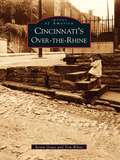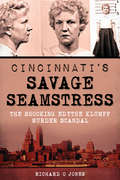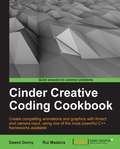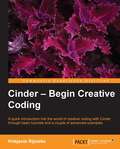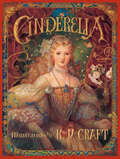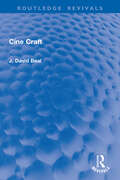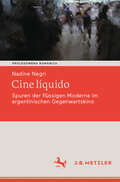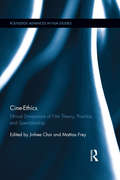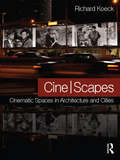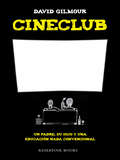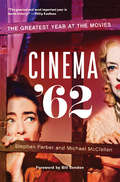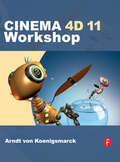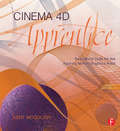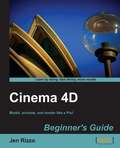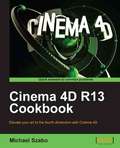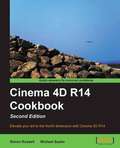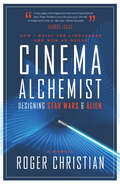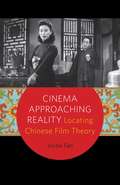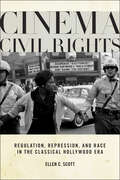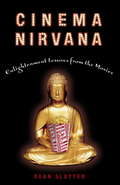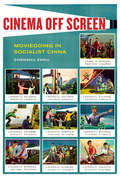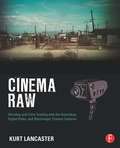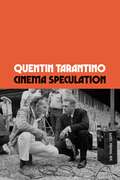- Table View
- List View
Cincinnati's Over-The-Rhine (Images of America)
by Tom White Kevin GraceCincinnati's Over-the-Rhine captures a fascinating urban neighborhood in vintage photographs. For over 150 years, the culture, politics, and architecture of Over-the-Rhine have influenced Cincinnati's development. Early German immigrants gave the neighborhood its moniker, after the bordering Miami-Erie canal, and also contributed to its beautiful architecture. Appalachian and African American citizens later contributed to the cultural diversity. Today, a vibrant arts scene co-exists along with revitalizing social programs that aid its underprivileged residents. Over 200 images reveal Over-the-Rhine's urban characters, street life, and architectural landmarks, including Music Hall, Findlay Market, and St. Mary's Church.
Cincinnati's Savage Seamstress: The Shocking Edythe Klumpp Murder Scandal (True Crime)
by Richard O JonesOn a cold, drizzly fall afternoon in 1958, a trio of duck hunters stumbled on the charred remains of Cincinnati resident Louise Bergen. When investigators learned that her estranged husband was living with an older divorcee, Edythe Klumpp, they wasted no time in questioning her. When she failed a lie detector test, Edythe spilled out a confession. Although it did not fit the physical evidence, she was found guilty and sentenced to death in the electric chair. Governor Michael V. DiSalle put his political career on the line to save Edythe from the death penalty, personally interviewing the prisoner while she was under the influence of "truth serum." But was it the truth? Richard O Jones separates the facts from the fiction in this comprehensive book about the Klumpp murder.
Cinder Creative Coding Cookbook
by Rui Madeira Dawid GornyFull of easy-to-follow recipes and images that will teach powerful techniques and algorithms, building from basic projects to challenging applications. This book is for artists, designers, and programmers who have previous knowledge of C++, but not necessarily of Cinder.
Cinder – Begin Creative Coding
by Krisjanis RijnieksPresented in an easy to follow, tutorial-style format, this book will lead you step-by-step through the multi-faceted uses of Cinder."Cinder: Begin Creative Coding" is for people who already have experience in programming. It can serve as a transition from a previous background in Processing, Java in general, JavaScript, openFrameworks, C++ in general or ActionScript to the framework covered in this book, namely Cinder. If you like quick and easy to follow tutorials that will let yousee progress in less than an hour - this book is for you. If you are searching for a book that will explain algorithms for complex 2D and 3D generative animations and use of advanced C++ and / or Open GL features - it is not.
Cinderella
by K. Y. CraftThis brilliant edition of a timeless story is sure to become the favorite of a generation. Readers young and old will be enchanted by the vision and mastery of Kinuko Y. Craft's luminous paintings, inspired by the lavish artwork of late seventeenth-century France and embellished with extraordinary borders and ornamentation. Rich with radiant color and astonishing detail, here is a dream come true for anyone who has ever believed in living happily ever after.
Cine Craft (Routledge Revivals)
by J. David BealCine Craft (1974) is an ideal guide to the world of amateur film making, a treasure-house of authoritative information. It covers the equipment, both basic and advanced, and the planning needed for a successful production. It looks at indoor and outdoor shooting, composition, exposure, continuity and camera movement, editing and titling, and the methods and use of recorded sound. An intriguing chapter deals with the various forms of cine animation using puppets, cut-outs and cells.
Cine líquido: Spuren der flüssigen Moderne im argentinischen Gegenwartskino (Prolegomena Romanica. Beiträge zu den romanischen Kulturen und Literaturen)
by Nadine NegriMitte der 90er Jahre wendet sich in Argentinien eine neue Kinoströmung radikal von den bis dato gültigen, vom Hollywoodkino inspirierten und pathetischen Filmstandards ab. Die von der Kritik schnell unter dem Sammelbegriff „Nuevo Cine Argentino“ zusammengefassten Werke zeichnen sich jedoch neben minimalistischen Tendenzen und Parallelen zum italienischen Neorealismus und der französischen „Nouvelle Vague“ insbesondere durch ihre Heterogenität aus. Die vorliegende Studie versteht das „Nuevo Cine Argentino“ als Manifestation einer ganzheitlichen soziokulturellen und geistigen Transformation: Die Entstehung des neuen argentinischen Films fällt mit einer Verflüssigung (Zygmunt Bauman), einer umfassenden Dynamisierung, Dezentralisierung und Individualisierung der westlichen Gesellschaften um die Jahrtausendwende zusammen. Die Studie geht von der Hypothese aus, dass sich gerade in den Eigenschaften des Flüssigen – Flexibilität, Flüchtigkeit und Formlosigkeit – ein Schlüssel für die Beschreibung des „Nuevo Cine Argentino“ findet. Sowohl inhaltlich auch formell finden sich in den Filmen Spuren der flüssigen Moderne. Anhand von zahlreichen bekannten, aber auch weniger rezipierten Filmen der letzten 25 Jahre erarbeitet die Autorin Charakteristika eines „cine líquido“. Dieses wird präsentiert als ein instrumenteller Kinomodus, der für die Darstellung von sozialen Verflüssigungsprozessen genutzt werden kann.
Cine-Ethics: Ethical Dimensions of Film Theory, Practice, and Spectatorship (Routledge Advances in Film Studies)
by Jinhee Choi Mattias FreyThis volume looks at the significance and range of ethical questions that pertain to various film practices. Diverse philosophical traditions provide useful frameworks to discuss spectators’ affective and emotional engagement with film, which can function as a moral ground for one’s connection to others and to the world outside the self. These traditions encompass theories of emotion, phenomenology, the philosophy of compassion, and analytic and continental ethical thinking and environmental ethics. This anthology is one of the first volumes to open up a dialogue among these diverse methodologies. Contributors bring to the fore some of the assumptions implicitly shared between these theories and forge a new relationship between them in order to explore the moral engagement of the spectator and the ethical consequences of both producing and consuming films
Cine-scapes: Cinematic Spaces in Architecture and Cities
by Richard KoeckCine-scapes explores the relationship between urban space, architecture and the moving image. While an impressive amount of research has been done with regards to the way in which architecture is portrayed in film, this book offers a new perspective.... What happens if we begin to see the city as a place for an embodied visual consumption; a visual apparatus or, perhaps, a system that is based on movement, light and the body, and which we can explore in kinematic, kinetic, and kinaesthetic ways? Using film as a lens through which we look at urban spaces and places, Richard Koeck reveals the filmic and cinematic phenomena and spatial qualities that are present in postmodern landscapes, and which are perhaps otherwise disregarded or merely passively consumed. Drawing on the author’s extensive knowledge derived from architectural and film practice, Cine-scapes: offers insight into architecture and urban debates through the eyes of a practitioner working in the fields of film and architectural design emphasizes how filmic/cinematic tendencies take place or find their way into urban practices can be used as a tool for educators, students and practitioners in architecture and urban design to communicate and discuss design issues with regard to contemporary architecture and cities Cine-scapes ignites new ways of seeing, thinking and debating the nature of architecture and urban spaces.
Cineclub
by David GilmourFue un trato muy poco convencional: Jesse podía dejar de ir al instituto, dormir todo el día, no trabajar, no pagar alquiler pero a cambio tenía que mantenerse alejado de las drogas y ver tres películas a la semana con su padre, el crítico de cine canadiense David Gilmour. Jesse aceptó de inmediato y al día siguiente padre e hijo comenzaron con la primera película de la lista: Los cuatrocientos golpes de François Truffaut. A lo largo de tres años padre e hijo vieron todo tipo de películas, desde las consideradas joyas del cine hasta los grandes bodrios de todos los tiempos. Con el trasfondo de El padrino, Instinto básico, Showgirls, Ciudadano Kane o La ley del silencio, David y Jesse hablan de los principales directores de cine, de las escenas célebres y de los actores que las protagonizaron, y poco a poco sobre todo tipo de temas: chicas, música, mal de amores, trabajo, drogas, talento, dinero, amor, amistad... Cineclub es un repaso personal de la historia del cine, un desafío a nuestras nociones de la educación y, sobre todo, la historia real y conmovedora acerca de cómo un padre y un hijo sortearon una época muy especial en su relación; en la que los hijos se encierran en sí mismos y los padres pierden la oportunidad de llegar a ellos. Esta es la historia de una decisión que lo cambió todo.
Cinema '62: The Greatest Year at the Movies
by Stephen Farber Michael McClellanLawrence of Arabia, The Miracle Worker, To Kill a Mockingbird, The Manchurian Candidate, Gypsy, Sweet Bird of Youth, The Longest Day, The Music Man, What Ever Happened to Baby Jane, and more. Most conventional film histories dismiss the early 1960s as a pallid era, a downtime between the heights of the classic studio system and the rise of New Hollywood directors like Scorsese and Altman in the 1970s. It seemed to be a moment when the movie industry was floundering as the popularity of television caused a downturn in cinema attendance. Cinema ’62 challenges these assumptions by making the bold claim that 1962 was a peak year for film, with a high standard of quality that has not been equaled since. Stephen Farber and Michael McClellan show how 1962 saw great late-period work by classic Hollywood directors like John Ford, Howard Hawks, and John Huston, as well as stars like Bette Davis, James Stewart, Katharine Hepburn, and Barbara Stanwyck. Yet it was also a seminal year for talented young directors like Sidney Lumet, Sam Peckinpah, and Stanley Kubrick, not to mention rising stars like Warren Beatty, Jane Fonda, Robert Redford, Peter O’Toole, and Omar Sharif. Above all, 1962—the year of To Kill a Mockingbird and The Manchurian Candidate—gave cinema attendees the kinds of adult, artistic, and uncompromising visions they would never see on television, including classics from Fellini, Bergman, and Kurosawa. Culminating in an analysis of the year’s Best Picture winner and top-grossing film, Lawrence of Arabia, and the factors that made that magnificent epic possible, Cinema ’62 makes a strong case that the movies peaked in the Kennedy era.
Cinema 4D 11 Workshop
by Arndt von KoenigsmarckModel, texture and animate with Cinema 4D 11 using the techniques and tips provided in Cinema 4D 11 Workshop. Starting with all of the basic concepts, functions, and tools - follow along to the workshop tutorials that deliver a hands-on knowledge of the new R11 toolset as well as the returning advanced features. The companion website provides all of the required tutorial media from the projects in the book so that you create your own working models and animations.
Cinema 4D Apprentice: Real-World Skills for the Aspiring Motion Graphics Artist (Apprentice Series)
by Kent McQuilkinNew to CINEMA 4D and looking for an accessible way to get up to speed quickly? Do you already know the basics of the software but need to know the new features or take your skills and understanding a little deeper? If so, look no further than CINEMA 4D Apprentice, your one-stop shop for learning this powerful application. With guidance that takes you beyond just the button-pushing, author Kent McQuilkin guides you through 10 core lessons, starting with the basics before moving onto more complex techniques and concepts and then tying it all together with a final project. CINEMA 4D Apprentice walks you through the software with a project-based approach, allowing you to put lessons learned into immediate practice. Best practices and workflows for motion graphics artists that can be applied to any software application are included. A companion website (www.focalpress.com/cw/mcquilkin) features project files and videos of the techniques in action. Topics covered include: creating basic scenes, modeling, texture mapping mograph in-depth integration with After Effects via CINEWARE lighting, animation, rendering and more motion tracking with the new tools included in R16
Cinema 4D Beginner's Guide
by Jen RizzoStep-by-step instructions with guiding screenshots will help new users to create a photorealistic interior scene with an animated camera. Users will also learn how to use the MoGraph module to create dynamic motion graphics, how to link parameters with Xpresso (Cinema 4D's node-based programming language), and are guided through mini-projects to explore additional tools for non-photorealistic illustrations, hair creation and cloth rendering. Designers and artists with a basic proficiency in animation or computer graphics, as well as professionals who are familiar with other 3D animation software.
Cinema 4D R13 Cookbook
by Michael SzaboThis book contains short recipes designed to effectively teach tools in the minimum amount of time. Each recipe hits on a topic that can be combined or incorporated with other recipes to give you the building blocks you need to start making great designs with Cinema 4D. Rather than demonstrating how to make a few specific and extensive projects, the recipes create a solid base of knowledge to help the reader understand the tools available to foster their own creativity. This book is for anyone who wants to quickly get up to speed with Cinema 4D to create 3D projects that run laps around simple 2D designs.
Cinema 4D R14 Cookbook
by Michael Szabo Simon RussellThis book is written in a Cookbook style with short recipes designed to effectively teach tools in the minimum amount of time. Each recipe hits on a topic that can be combined or incorporated with other recipes to give you the building blocks you need to start making great designs with Cinema 4D. Rather than demonstrating how to make a few specific and extensive projects, the recipes create a solid base of knowledge to help the reader understand the tools available to foster their own creativity.This book is for professional artists working in architecture, design, production, or games and wanting to use Cinema 4D to create amazing 3D graphics. It is for anyone who wants to quickly get up to speed with Cinema 4D to create 3D projects that run laps around simple 2D designs.
Cinema Alchemist: Designing Star Wars and Alien
by Roger ChristianFor the first time, Oscar-winning production designer and director Roger Christian reveals his life story, from his earliest work in the British film industry to his breakthrough contributions on such iconic science fiction masterpieces as Star <P> Wars, Alien and his own rediscovered Black Angel.This candid biography delves into his relationships with legendary figures, as well as the secrets of his greatest work. The man who built the lightsaber finally speaks!
Cinema Approaching Reality: Locating Chinese Film Theory
by Victor FanIn Cinema Approaching Reality, Victor Fan brings together, for the first time, Chinese and Euro-American film theories and theorists to engage in critical debates about film in Shanghai and Hong Kong from the 1920s through 1940s. His point of departure is a term popularly employed by Chinese film critics during this period, bizhen, often translated as &“lifelike&” but best understood as &“approaching reality.&” What these Chinese theorists mean, in Fan&’s reading, is that the cinematographic image is not a form of total reality, but it can allow spectators to apprehend an effect as though they had been there at the time when an event actually happened. Fan suggests that the phrase &“approaching reality&” can help to renegotiate an aporia (blind spot) that influential French film critic André Bazin wrestled with: the cinematographic image is a trace of reality, yet reality is absent in the cinematographic image, and the cinema makes present this absence as it reactivates the passage of time. Fan enriches Bazinian cinematic ontology with discussions on cinematic reality in Republican China and colonial Hong Kong, putting Western theorists—from Bazin and Kracauer to Baudrillard, Agamben, and Deleuze—into dialogue with their Chinese counterparts. The result is an eye-opening exploration of the potentialities in approaching cinema anew, especially in the photographic materiality following its digital turn.
Cinema Civil Rights
by Ellen C. ScottFrom Al Jolson in blackface to Song of the South, there is a long history of racism in Hollywood film. Yet as early as the 1930s, movie studios carefully vetted their releases, removing racially offensive language like the "N-word." This censorship did not stem from purely humanitarian concerns, but rather from worries about boycotts from civil rights groups and loss of revenue from African American filmgoers.Cinema Civil Rights presents the untold history of how Black audiences, activists, and lobbyists influenced the representation of race in Hollywood in the decades before the 1960s civil rights era. Employing a nuanced analysis of power, Ellen C. Scott reveals how these representations were shaped by a complex set of negotiations between various individuals and organizations. Rather than simply recounting the perspective of film studios, she calls our attention to a variety of other influential institutions, from protest groups to state censorship boards.Scott demonstrates not only how civil rights debates helped shaped the movies, but also how the movies themselves provided a vital public forum for addressing taboo subjects like interracial sexuality, segregation, and lynching. Emotionally gripping, theoretically sophisticated, and meticulously researched, Cinema Civil Rights presents us with an in-depth look at the film industry's role in both articulating and censoring the national conversation on race.
Cinema Houston
by David WellingCinema Houston celebrates a vibrant century of movie theatres and moviegoing in Texas's largest city. Illustrated with more than two hundred historical photographs, newspaper clippings, and advertisements, it traces the history of Houston movie theatres from their early twentieth-century beginnings in vaudeville and nickelodeon houses to the opulent downtown theatres built in the 1920s (the Majestic, Metropolitan, Kirby, and Loew's State). It also captures the excitement of the neighborhood theatres of the 1930s and 1940s, including the Alabama, Tower, and River Oaks; the theatres of the 1950s and early 1960s, including the Windsor and its Cinerama roadshows; and the multicinemas and megaplexes that have come to dominate the movie scene since the late 1960s. While preserving the glories of Houston's lost movie palaces-only a few of these historic theatres still survive-Cinema Houston also vividly re-creates the moviegoing experience, chronicling midnight movie madness, summer nights at the drive-in, and, of course, all those tasty snacks at the concession stand. Sure to appeal to a wide audience, from movie fans to devotees of Houston's architectural history, Cinema Houston captures the bygone era of the city's movie houses, from the lowbrow to the sublime, the hi-tech sound of 70mm Dolby and THX to the crackle of a drive-in speaker on a cool spring evening.
Cinema Illuminating Reality: Media Philosophy through Buddhism
by Victor FanA new critical approach to cinema and media based on Buddhism as a philosophical discourse How can a philosophical discourse generated in Asia help us reframe and renew cinema and media theory? Cinema Illuminating Reality provides a possible way to do this by using Buddhist ideas to examine the intricate relationship between technicity and consciousness in the cinema. The resulting dialogue between Buddhism and Euro-American philosophy is the first of its kind in film and media studies.Victor Fan examines cinema&’s ontology and ontogenetic formation and how such a formational process produces knowledge, political agency, and in-aesthetics. Buddhism allows Fan to deconstruct binary thinking and reimagine media as an ecology, rethinking cinema in relational terms between the human and the machine. Along the way, Fan considers a wide variety of case studies from around the globe, while paying special attention to how contemporary Tibeto-Sinophone filmmakers have adopted relational thinking to detail ways of rebuilding a world that appears to be beyond repair.From Chinese queer cinema to a reexamination of Japanese master Ozu&’s work and its historical reception to Christian Petzold&’s 2018 existential thriller Transit, CinemaIlluminating Reality forges a remarkable path between Buddhist studies and cinema studies, casting vital new light on both of these important subjects.
Cinema Nirvana
by Dean SluyterMovie fans and spiritual seekers, unite! In Cinema Nirvana, meditation teacher and award-winning film critic Dean Sluyter illuminates the hidden enlightenment teachings of Casablanca, Jaws, The Graduate, The Godfather, Memento, and ten other classic films, revealing spiritual wisdom in everything from 007's secret weapons to the colors of the Seven Dwarfs' eyes. So grab your popcorn, sit back, and prepare to have your mind opened.
Cinema Off Screen: Moviegoing in Socialist China
by Chenshu ZhouAt a time when what it means to watch movies keeps changing, this book offers a case study that rethinks the institutional, ideological, and cultural role of film exhibition, demonstrating that film exhibition can produce meaning in itself apart from the films being shown. Cinema Off Screen advances the idea that cinema takes place off screen as much as on screen by exploring film exhibition in China from the founding of the People’s Republic in 1949 to the end of the Cold War in the early 1990s. Drawing on original archival research, interviews, and audience recollections, Cinema Off Screen decenters the filmic text and offers a study of institutional operations and lived experiences. Chenshu Zhou details how the screening space, media technology, and the human body mediate encounters with cinema in ways that have not been fully recognized, opening new conceptual avenues for rethinking the ever-changing institution of cinema.
Cinema Raw: Shooting and Color Grading with the Ikonoskop, Digital Bolex, and Blackmagic Cinema Cameras
by Kurt LancasterWith the next generation of raw cinema cameras you can finally shoot professionally with uncompressed raw motion pictures—without compromising your image or your budget. In Cinema Raw: Shooting and Color Grading with the Ikonoskop, Digital Bolex, and Blackmagic Cinema Cameras, Lancaster takes you through the birth of these new cameras and includes an exclusive behind-the-scenes look at Digital Bolex. He field tests each camera and discusses the importance of shooting in raw and guides you through the raw color grading process so you can create stunning films. Interviews with professionals who have shot documentaries, shorts, and promotionals with these cameras are featured throughout, allowing you to learn field production techniques under real world conditions. FEATURES: Behind-the-scenes case studies for the next generation of low budget cinema cameras Recommended gear lists to begin your raw shooting experience Full color post workflows that help you realize your boldest cinematic visions A companion website (www.kurtlancaster.com) featuring raw projects covered in the book; video interviews with the creators of the Digital Bolex, Joe Rubinstein and Elle Schneider; and resources for further study of raw cinema
Cinema Speculation
by Quentin TarantinoA unique cocktail of personal memoir, cultural criticism and Hollywood history by the one and only Quentin Tarantino.The long-awaited first work of nonfiction from the author of the number one New York Times bestselling Once Upon a Time in Hollywood: a deliriously entertaining, wickedly intelligent cinema book as unique and creative as anything by Quentin Tarantino.In addition to being among the most celebrated of contemporary filmmakers, Quentin Tarantino is possibly the most joyously infectious movie lover alive. For years he has touted in interviews his eventual turn to writing books about films. Now, with CINEMA SPECULATION, the time has come, and the results are everything his passionate fans - and all movie lovers - could have hoped for. Organized around key American films from the 1970s, all of which he first saw as a young moviegoer at the time, this book is as intellectually rigorous and insightful as it is rollicking and entertaining. At once film criticism, film theory, a feat of reporting, and wonderful personal history, it is all written in the singular voice recognizable immediately as QT's and with the rare perspective about cinema possible only from one of the greatest practitioners of the artform ever.
